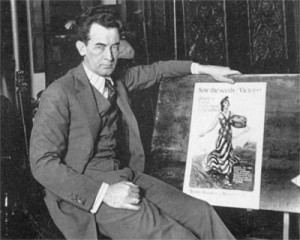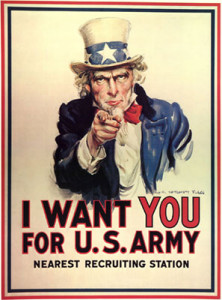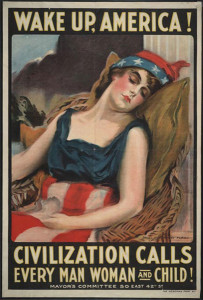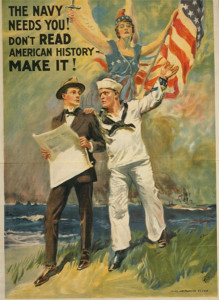Flags painted by Flagg, painter
 After Norman Rockwell, James Montgomery Flagg might be the best-known popular painter of the 20th century. Given his name, it’s no surprise that his artwork contained so many images of bright stars and broad stripes.
After Norman Rockwell, James Montgomery Flagg might be the best-known popular painter of the 20th century. Given his name, it’s no surprise that his artwork contained so many images of bright stars and broad stripes.
If you can picture Uncle Sam pointing his finger at you, you know Flagg’s most famous work – and maybe what he looked like. Born in 1877, he was not only an illustrator for magazines but also a screenwriter for silent films, creator of movie posters and draftsman of newspaper ads.
 He got many commissions from the U.S. government for recruiting posters and other patriotic images in the lead-up to World War I. In 1916, he proposed painting “Twentieth Century American Venus,” showing a semi-nude and armless woman draped in an American flag and topped by a Liberty cap.
He got many commissions from the U.S. government for recruiting posters and other patriotic images in the lead-up to World War I. In 1916, he proposed painting “Twentieth Century American Venus,” showing a semi-nude and armless woman draped in an American flag and topped by a Liberty cap.
A newspaper article said that “Flagg has painted her to represent Columbia helpless – Columbia appealing to 30,000 engineers in the United States, upon whom, in time of emergency, the burden of mobilizing American industry would fall.” The image was a pun: The nation was as armless (i.e. weapon-less) as Venus.
Flagg would create nearly four dozen patriotic images preceding WWI.  One showed a slumbering woman dressed in stars and stripes. “Wake up, America!” the poster cries. “Civilization calls.”
One showed a slumbering woman dressed in stars and stripes. “Wake up, America!” the poster cries. “Civilization calls.”
Recruiting posters were also needed to raise an army and navy. One of Flagg’s ideas became an immortal image. Originally painted as a cover for a weekly magazine, his iconic Uncle Sam first asked, “What Are You Doing for Preparedness?”
The portrait became “the most famous poster in the world.” That claim was Flagg’s own boast, but he had ample evidence for it. More than four million copies of the poster were churned out between 1917 and 1918, as the United States headed off to war.
 In addition to the image of a top-hatted man with the pointing finger, the poster contained a simple command as its caption: “I Want You.” The poster returned to prominence in World War II, and it has shown up in many forms – and imitations – since.
In addition to the image of a top-hatted man with the pointing finger, the poster contained a simple command as its caption: “I Want You.” The poster returned to prominence in World War II, and it has shown up in many forms – and imitations – since.
As for the model used for Uncle Sam, Flagg claimed he painted his own face, aged to look like a venerable man. The painter would eventually make it to Uncle Sam’s years. He died in 1960 at 82 and left this message in his will: “Peace, goodness and beauty is evident in spite of horror.”
